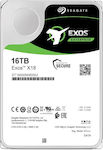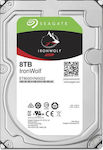Tool with everything. It is the third Synology I buy, after the DS214 and DS416play, which have served me well for years. This particular one, besides being an amazing machine in terms of performance and software, is also a very good investment. Let's see why.
- 8 drive bays, which are enough for a large capacity, depending on the drives you install. And if you still want more, you can reach up to 18 with the addition of two DX517 units, so you don't need to replace it. Personally, I currently have it with 8 drives, one array with 7 drives (5 + 2 RAID6) and an additional hot spare for immediate and automatic repair in case one fails. With 6TB WD Red Plus drives, I have about 28TB of usable space, and if I add the hot spare to the array, I have about 34TB, which is more than enough for me. If you want even more without expansion, it supports up to 14TB and 16TB units.
- I won't write much about the software, it's better if you read about it on the product page. For me, it's the best NAS software. For those who know, it supports Docker and has an awesome default Virtualization Manager.
- The power of the Ryzen V1500B is impressive, the system's response is instant in everything. It comes with 4GB of memory, easily expandable (with a slot) up to 32GB. Just be aware that it requires ECC RAM.
- It accepts 2 M.2 SSDs for caching in case you integrate it into an environment with heavy loads, but for my home use, I don't need it.
- The great thing is that it has a PCI-E slot that accepts a 10GBe/20GBe card, so you can be future-proof in terms of its network connection.
The migration from the 416 literally took 10 minutes. I took the drives out of the 416, put them in the 1821, it rebooted, and started as if nothing had changed. It's very quiet, of course, that's why I prefer 5400 RPM drives. With 7200 RPM drives, it would be a bit noisier. The price is definitely high, there's no discussion about it. However, it's a machine that you will keep for many years, and during all those years, it will work without any problems, without intervention, without anything.
EDIT: 17/12/2021.
I upgraded the RAM from 4GB to 16GB so that I can comfortably run VMs on it. I didn't use Synology RAM because the price is outrageous for no reason (16GB costs 370€), but I used Samsung ECC 16GB, Part number: M474A2K43DB1-CVF, which cost me 140€ and works perfectly since Synology's "mother" memory is also Samsung. You can easily find it in Europe, I got mine from esus-it. I deployed two VMs, one Ubuntu and one Windows 11. Ubuntu runs smoothly with 4GB, as expected, and it handles various tasks (Unify Network Controller, etc.) without any issues. Windows runs relatively well, but it struggles with graphics and visual effects because the V1500B, as an embedded CPU, doesn't have a dedicated GPU, so it emulates the GPU part.
The two VMs were installed on a Samsung 870 EVO SSD that I placed in the last drive bay and created a separate Storage Pool for it, so they load and run smoothly. Initially, they were created in the HDD Pool, but I easily migrated them to the other Pool, thanks to one of the great features of the Virtualization Manager. The other great feature is the Snapshot/Replication, which allows you to save snapshots of any VM at any time, so you can experiment freely and then easily revert back.
EDIT: 31/10/2023.
Obviously, it still works perfectly. I installed a 10Gbit PCI-E card to have a 10Gbit connection between the NAS and my PC. I wanted a card with 2xSFP+ ports to connect to the Unifi Switch Aggregation that is already connected to my PC with an Asus XG-C100F and DAC cable. And here there is no reason to buy the genuine one that costs 300€+, we can get the exact same one as the original card. We searched on eBay for the Mellanox ConnectX-3 Pro PCIe x8 NIC 10GBe SFP+ card with the code MCX312B-XCCT, which is EXACTLY THE SAME card that Synology provides without the sticker. Cost is 80€. There is also a slightly cheaper one with 1xSFP+ port, but with a small difference that for me there was no reason, as both support LACP. It worked perfectly from the start and now the transfer speed to/from the NAS has increased to 440 MB/s from the previous limit of 110 MB/s of the GbE connection. Note that I have regular WD RED drives at 5400rpm. In tests with Red PRO drives, the numbers go over 600+ MB/s.
Overall, the capabilities of the device are much more than a simple NAS, and everything that has been implemented works flawlessly.













































